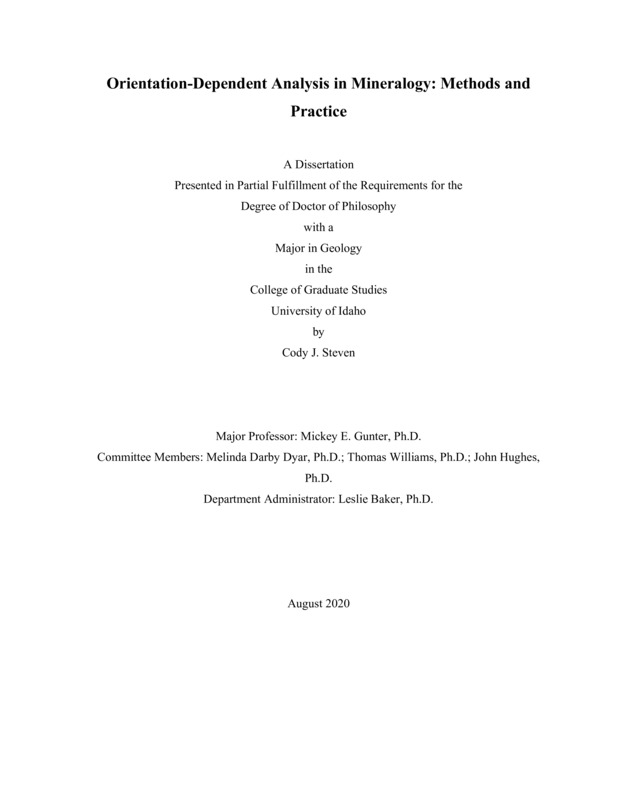Orientation-Dependent Analysis in Mineralogy: Methods and Practice
Steven, Cody. (2020-06). Orientation-Dependent Analysis in Mineralogy: Methods and Practice. Theses and Dissertations Collection, University of Idaho Library Digital Collections. https://www.lib.uidaho.edu/digital/etd/items/steven_idaho_0089e_11928.html
- Title:
- Orientation-Dependent Analysis in Mineralogy: Methods and Practice
- Author:
- Steven, Cody
- Date:
- 2020-06
- Keywords:
- HRTEM modulation optical crystallography orientation ultramafic X-ray absorption
- Program:
- Geology
- Subject Category:
- Mineralogy
- Abstract:
-
The central theme of this dissertation is the importance of orientation when analyzing an anisotropic mineral. Whether this is for identifying the mineral or for characterizing composition or structure, information about the orientation of a particular characteristic can provide unique information about the mineral. For example, in visible light optics of anisotropic minerals, a crystal will have differing refractive indices based on the incoming wavelength and orientation in which light is vibrating through the crystal. These properties are dictated by the chemical composition and structure of the mineral, and when combined with other information about the crystal, such as the locations of crystallographic planes, absorption characteristics, and relative refractive indices, an unknown mineral can be narrowed down often to a particular species using optical mineralogy alone. If a crystal contains proper rotational symmetry, these axes will also correspond with the rotational symmetry of the optical indicatrix, which can be used in crystal structure determination. In absorption spectroscopy, there is evidence that polarization effects from anisotropic crystals influence relative absorption magnitudes outside of the visible light spectrum, even at X-ray wavelengths. In high resolution transmission electron microscopy, image resolution is markedly improved by imaging sections viewing down zone axes, where atomic columns are largely in line. Additionally, electron diffraction patterns viewing down zone axes provide more information about symmetry and structural periodicities. By knowing the orientation of a crystal in thin section, TEM mounts can target specific zone axis orientations of a crystal to obtain meaningful structural information. With knowledge of orientation, precession electron diffraction tomography is expedited when collecting intensity maxima near zone axes, which supplements ab initio structural determination of difficult structures, such as strongly disordered and/or modulated crystal structures.
The contents of this dissertation proceed with calculations and methods for orienting crystals by their crystallographic and optical orientations. Using these methods, the remainder of this dissertation outline applications of these methods applied to optical characterization and identification of minerals, an orientation and ferric content model for iron K X-ray absorption in pyroxenes, and a study on structural variation and defects in serpentine minerals and amphiboles from Western Idaho, and their relation to geology and asbestiform mineral occurrences.
- Description:
- doctoral, Ph.D., Geology -- University of Idaho - College of Graduate Studies, 2020-06
- Major Professor:
- Gunter, Mickey E
- Committee:
- Dyar, Melinda D; Williams, Thomas; Hughes, John
- Defense Date:
- 2020-06
- Identifier:
- Steven_idaho_0089E_11928
- Type:
- Text
- Format Original:
- Format:
- application/pdf
- Rights:
- In Copyright - Educational Use Permitted. For more information, please contact University of Idaho Library Special Collections and Archives Department at libspec@uidaho.edu.
- Standardized Rights:
- http://rightsstatements.org/vocab/InC-EDU/1.0/

